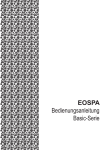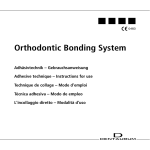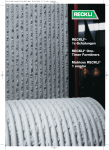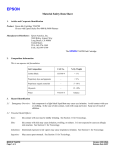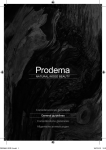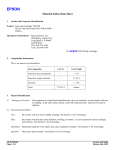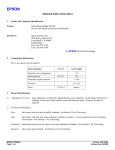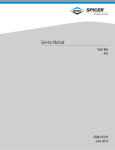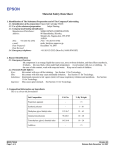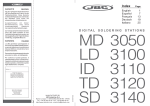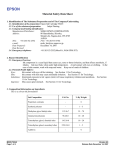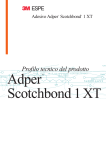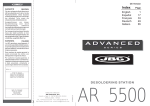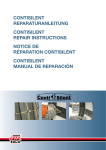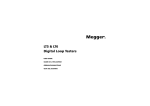Download REF RC03 - bei Tokuyama Dental!
Transcript
Instruction for use Gebrauchsinformation Notice d’utilisation Istruzioni per l’uso Instrucciones de uso 0123 5253170207 Adhesive Resin Cement Adhäsiv-Kunststoffzement Ciment résine adhésif Cemento resina adesivo Cemento de resina ޓ٨ޓ٨ޓ٨ޓ٨ޓ٨ޓ٨ޓ٨ޓ٨ޓ٨ޓ٨ޓ٨ޓ٨ޓ٨ޓ٨ޓ٨ޓ٨ޓ٨ޓ٨ޓ٨ޓ٨ޓ٨ޓ٨ޓ٨ Read all Information, Precautions and Notes before using M-BOND. Contents Kit: Mini Kit: Powder (Clear) 3g Powder (Clear) Powder (Ivory) 3g Powder (Ivory) Liquid 8mL Liquid Primer A 3mL Primer A Primer B 3mL Primer B Mixing Dish 1 Mixing Dish Powder Measuring Spoon 1 Powder Measuring Spoon Spatula 1 Spatula Brush Handle 2 Brush Handle Disposable Brush Tip 50 Disposable Brush Tip Disposable Brush Tip (for Brush-on) 10 Disposable Brush Tip (for Brush-on) Refill: Powder (Clear) 3g Liquid Powder (Ivory) 3g Primer A Powder (Dentin) 3g Primer B Disposable Brush Tip Powder (Opaque ivory (radiopaque)) 4g Powder (Opaque dentin (radiopaque)) 4g Disposable Brush Tip (for Brush-on) 50 (with Brush Handle x 1) 1g 1g 3mL 1mL 1mL 1 1 1 2 50 10 8mL 3mL 3mL 100 Features *Reapply surface protection again if unexpected removal of protection film occurs. Precious Metal Alloys - Alumina-sandblast, clean ultrasonically, and dry all in the same manner non-precious metal alloys are treated. After these steps are completed, treat metal surface to be bonded with METALTITE (sold separately) or tinplate. *If unable to sandblast the prosthesis, roughen the surface with a bur, diamond point, etc. *Do not allow saliva or blood to come in contact with or apply any etching material to the prosthesis surface that has been treated with METALTITE or tin-plated. *If the treated surface is contaminated by saliva or blood, clean the surface ultrasonically to remove all contamination. *When using a primer for precious metals to replace tin-plating, such as METALTITE, be sure to refer to the instruction manual of the product being used. *Reapply surface protection if unexpected removal of protection film occurs. Ceramics *Be sure to read Precautions 1). - When treating porcelain, castable ceramics, machinable ceramics, etc., roughen the prosthesis to create a fresh bonding surface, clean ultrasonically and allow to dry completely. - Silane treatment; mix and apply TOKUSO CERAMIC PRIMER (sold separately) for 10 seconds, gently blow with air. Resins Composite resins for crown & bridge; treat surfaces the same as stated above under Ceramics. 1) PMMA type resin cement 2) High bonding strength 3) Excellent adhesive durability 4) Extended working time, 1 minute 40 seconds at room temperature 5) No rinse needed thanks to self-etching priming system Working Time Ingredients Precautions Description Primer A Primer B Powder Liquid Principal ingredients phosphoric acid monomer / acetone water / acetone / borate catalyst PMMA / BPO MMA / MAC-10 / methacrylate monomers / amine Clinical Usage Applications Bonding of metal inlay, onlay and crowns Bonding of cast/prefabricated post Bonding of adhesive/Maryland bridge Bonding of adhesive splint Fixation of loose tooth Temporary repair of chipped tooth Repair of fractured tooth Bonding of orthodontic bracket/ retainer Mixing method Brush-on method A A A A A A A A N/A A N/A A N/A A N/A A A: Available N/A: Not Available CONTRAINDICATIONS M-BOND contains methacrylic monomers. M-BOND is contraindicated in patients allergic to or hypersensitive to methacrylic and related monomers and should NOT be used in such patients. Clinical Application This consists of three sections Basic Procedure, Pretreatment of Tooth, Pretreatment of Prosthesis. See each section for details. Basic Procedure 1. Pretreatment of prosthesis Refer to “Pretreatment of Prosthesis”. 2. Cleaning of Cavity/Abutment Remove all contamination from the tooth surface, i.e. plaque, etc., with a brush or ultrasonic scaler. Mechanically remove temporary sealer, temporary cement, etc. by ultrasonic scaler, etc. if it sticks firmly. 3. Pretreatment of Tooth Surface Refer to “Pretreatment of tooth surface”. 4. Mixing and Applying M-BOND Powder & Liquid 1. Mixing method - “Regular” Mix: Dispense 3 drops of Liquid and 1 full scoop of powder, “Regular” side into Mixing Dish, and mix with Spatula. - “Small” Mix: Dispense 2 drops of Liquid and 1 full scoop of powder, “Small” side into Mixing Dish and mix. - Apply the mixture to the surface to be bonded before the mix gets stringy. *To avoid unexpected hardening of M-BOND with Primer, DO NOT apply the mixture to the tooth surface. Especially in the case of bonding posts, NEVER place the mixture in the root canal. Be sure to apply the mixture to the post and then set into the root canal. 2. Brush-on method - Place Powder and Liquid in separate wells of the Mixing Dish. - Immerse the Brush tip fully in the Liquid and touch the Powder with the Brush Tip to create mixture of cement on it. - Place the mixture of cement on the surface to be bonded. 5. Prosthesis Seating, Pressing and Removal of Excess Cement - Seat the prosthesis, press it to ensure the proper bond. - Remove the excess cement IMMEDIATELY. 6. Curing and Finishing - Allow M-BOND to cure while applying pressure on the prosthesis and allow to set 4 minutes. - 4 minutes after seating the prosthesis, the cement will be completely hard. Follow standard procedures to polish and check the patient’s bite. Be sure to perform occlusal adjustment. Pretreatment of Tooth (complete treatment : no rinsing necessary) 1. Cleaning [Fixation of a Loose Tooth] - Clean tooth surface to be bonded thoroughly of all contaminates. - Perform scaling in advance if tartar and/or precipitate (plaque, biofilm etc.) are observed. *In the case of treatment with phosphoric acid etching agent, rinse and dry then treat with Primers. [Bonding of Prosthesis / Restoration] - Remove any of the following factors that inhibit curing by thoroughly cleaning the tooth surface with alcohol, citric acid, EDTA, or phosphoric acid for 2-3 seconds before pretreatment of tooth surface: 1) temporary sealer, temporary cement, temporary crown 2) silicone oil of fit check material 3) oil mist from handpiece 4) saliva, blood and exudate 2. Apply Primer A / B - Place one drop each of Primer A and B into the Mixing Dish. - Mix thoroughly and evenly with the Brush. - Immediately apply mixed Primer onto the entire tooth surface. - Allow Primer to sit for 30 seconds. 3. Dry - Use a weak-medium air stream for 5 – 10 seconds (Do Not Rinse). Pretreatment of Prosthesis Prosthesis made of metal (non-precious and precious), resins and ceramics. The preparation of the respective surfaces prior to treatment is as follows: Protection of Prosthesis Surface Protect the prosthesis surface Not to be bonded, with metal separator, paraffin film, Vaseline, etc., if necessary. Non-precious Metal Alloys - Clean prosthesis surface fully and alumina-sandblast. - Ultrasonically clean the prosthesis, allow to dry. *Sandblasting should be done with 30 to 50 µm alumina beads. *If unable to sandblast the prosthesis, roughen the surface with a bur, diamond point, etc. Working time of M-BOND is 1 minute 40 seconds (until the mixture becomes stringy) at room temperature (25 o C / 77 o F). 1) When using M-BOND for cementing ceramic restorations, be sure to confirm whether or not the restorations are made of Alumina and/or Zirconia. DO NOT APPLY TOKUSO CERAMIC PRIMER for Alumina and/or Zirconia restorations. It will adversely affect optimum cementation of these restorations. For Alumina and/or Zirconia restorations, simply roughen restoration surfaces by using a sandblaster or diamond bur before cementing. 2) M-BOND is designed for sale to licensed dental care professionals only. It is not designed for sale to nor is it suitable for use by non-dental care professionals. 3) Use M-BOND only as instructed, DO NOT use M-BOND for any application other than those noted in the Instructions. 4) If patient experiences an allergic reaction or sensitivity to M-BOND, such as dermatitis eruption, discontinue its use immediately. 5) Avoid contact of any M-BOND components with eyes. If contact with eyes occurs, thoroughly flush eyes with water, and immediately contact a physician. 6) If any of M-BOND components contacts skin or clothing, clean it off immediately with an alcohol soaked cotton gauze. 7) Contact of any of M-BOND components with mucosal membrane may result in a whitening of the affected area due to a protein coagulation by acid monomer (whitened color will disappear within 1-2 days). If contact with mucosal membrane occurs, immediately wipe the area away and thoroughly flush with water. 8) Avoid ingestion of any of M-BOND components because it is acidic. 9) If the cavity is immediately proximate to the pulp, pulp should be protected with a Glass Ionomer lining or calcium-hydroxide. DO NOT USE EUGENOL MATERIALS to protect the pulp. Eugenol material will inhibit curing of M-BOND. 10) Use examination gloves at all times while using M-BOND to avoid the possibility of allergic reactions from methacrylic monomers. When the examination gloves come in contact with any of M-BOND components, dispose of the examination gloves immediately and use new examination gloves. 11) Avoid open flames when using M-Bond, since Liquid, Primer A and Primer B are flammable. 12) To avoid cross infection, DO NOT reuse Disposable Brush Tips. Clean the Mixing Dish, Spatula, Brush Handle and Spoon. 13) Open the Liquid and Primers carefully. The internal vapor pressure might splash the liquid. 14) Remove excess cement IMMEDIATELY after pressing the prosthesis/ restoration, since the hardened M-BOND is difficult to remove. 15) M-BOND SHOULD NOT BE MIXED OR USED with other types or brands of resin cements. 16) DO NOT line cavity with any type of cement before applying M-BOND. 17) Primers are highly volatile. Be sure to ventilate the room and screw the caps tightly within 3 minutes of using. 18) DO NOT remove protective cover from the Primer bottles (It is designed to dispense the Primers smoothly). 19) Remove the polymerization inhibitors such as temporary sealers, temporary cements and oil from fit checking materials completely from the surface to be bonded. 20) Do not use this product if the safety seals are broken or if the contents have been tampered with. 21) It is recommended that rubber to be attached to the Mixing Dish during the clinical procedure. Clean the Mixing Dish immediately after use because cleaning of the Mixing Dish becomes difficult after the hardening of M-BOND. If hardening occurs, immerse the Mixing Dish with the adhered M-BOND in warm water and then clean it. 22) Soften Brush Tip prior to use by immersing the tip fully in M-BOND Liquid while rubbing the Brush Tip on the bottom of the Mixing Dish. 23) When using brush-on procedure, dispose of remaining Powder and Liquid after use. Storage 1) Before and After Opening: Store M-BOND under refrigeration at a temperature between 0-10 ºC (32-50 ºF). Long periods of storage at room temperature may result in incomplete polymerization of paste due to deterioration. 2) DO NOT use M-BOND after the indicated date of expiration. 3) DO NOT leave M-BOND within reach of patients or children. Disposal To safely dispose of M-BOND components, remove unused product from the bottles, soak the liquid in tissue paper and dispose of it in accordance with local regulations. *The manufacturer is not responsible for damage or injury caused by improper use of this product. It is the personal responsibility of the user to ensure the product is suitable for an appropriate application before use. Specifications are subjected to change without notification. DEUTSCH ޓ٨ޓ٨ޓ٨ޓ٨ޓ٨ޓ٨ޓ٨ޓ٨ޓ٨ޓ٨ޓ٨ޓ٨ޓ٨ޓ٨ޓ٨ޓ٨ޓ٨ޓ٨ޓ٨ޓ٨ޓ٨ޓ٨ޓ٨ Vor der Anwendung von M-BOND lesen Sie bitte alle Informationen, Vorsichtsmaß nahmen und Anmerkungen sorgfältig durch. Packungsinhalt Normal-Packung Mini Kit Pulver (transparent) 3g Pulver (transparent) Pulver (zahnfarben) 3g Pulver (zahnfarben) Flüssigkeit 8mL Flüssigkeit Primer A 3mL Primer A Primer B 3mL Primer B Anmischplatte 1 Anmischplatte Pulvermesslöffel 1 Pulvermesslöffel Spatel 1 Spatel Pinselhalter 2 Pinselhalter Einwegpinsel 50 Einwegpinsel Einwegpinsel (für die brush-on-Technik) 10 Einwegpinsel (für die brush-on-Technik) Nachfüll-Packung Pulver (transparent) 3g Flüssigkeit Pulver (zahnfarben) 3g Primer A Pulver (Dentin) 3g Primer B Einwegpinsel Pulver (Opak elfenbeinfarbe (radiumopak)) 4g Pulver (Opak dentin (radiumopak)) 4g Einwegpinsel (für die brush-on-Technik)50 (+ Pinselhalter x 1) Produkteigenschaften 1) PMMA-Kunststoffzement 2) Hohe Haftkraft 3) Ausgezeichnete Haftbeständigkeit 4) Verlängerte Verarbeitungszeit, 1 Minute 40 Sekunde bei Raumtemperatur Verarbeitungszeit CONTRE-INDICATIONS Die Verarbeitungszeit von M-BOND beträgt 1 Minute 40 Sekunden (bis die Mischung zäh wird) bei Raumtemperatur (25 oC / 77 oF). M-BOND contient des monomèresméthacryliques. NE PAS UTILISER M-BOND chez les patients allergiques ou hypersensibilisés aux monomères méthacryliques et apparentés et NE DOIT PAS être utilisés chez ces patients. Beschreibung Primer A Primer B Pulver Flüssigkeit REF RC03 ENGLISH 5) Dank eines selbstätzenden Primers kein Absprayen erforderlich Bestandteile 1g 1g 3mL 1mL 1mL 1 1 1 2 50 10 8mL 3mL 3mL 100 Hauptbestandteile Phosphorsäure-Monomer / Aceton Wasser / Aceton / Borat-Katalysator PMMA / BPO MMA / MAC-10 / Methacrylat-Monomere / Amin Klinische Anwendung Anwendungen Mischverfahren Brush-on-Verfahren Adhäsive Befestigung von metallischen Inlays, Onlays und Kronen A A Adhäsive Verankerung von konfektionierten oder gegossenen Stiften A A Befestigung von Klebe-/Marylandbrücken A A Verankerung von Klebeschienungen A A Schienung gelockerter Zähne N/A A Provisorisches Reparieren abgesprungener Zähne N/A A Reparatur frakturierter Zähne N/A A Adhäsive Befestigung kieferorthopädischer Brackets oder Retainer N/A A A: Anwendbar N/A: Nicht anwendbar GEGENANZEIGEN M-BOND enthält Methacrylat-Monomere. M-BOND ist bei Patienten, die gegen Methacrylat-Monomere oder verwandte Monomere allergisch oder überempfindlich sind, kontradindiziert und darf bei diesen Patienten NICHT angewendet werden. Klinische Vorgehensweise Diese besteht aus den drei Abschnitten Grundverfahren, Vorbehandlung der Zahnoberfläche und Vorbehandlung der Restaurationen. Für Einzelheiten siehe jeweiligen Abschnitt. Grundverfahren 1. Vorbehandlung der Restaurationen Siehe “Vorbehandlung der Restaurationen”. 2. Reinigung der Kavität/Pfeiler Sämtliche Verschmutzungen von der Zahnoberfläche, d.h. Plaques usw. durch Bürsten oder Ultraschallzahnreinigung entfernen. Sollten provisorische Versiegeler, Zement usw. fest haften, diese durch Ultraschallreinigung mechanisch entfernen. 3. Vorbehandlung der Zahnoberfläche Siehe “Vorbehandlung der Zahnoberfläche”. 4. Mischen und Auftragen von M-BOND Pulver & Flüssigkeit 1. Mischverfahren - “Normale” Mischung: 3 Tropfen der Flüssigkeit und 1 vollen Löffel Pulver (Seite mit der Aufschrift “Regular“) auf die Anmischplatte geben und mit dem Spatel mischen. - “Kleine” Mischung: 2 Tropfen der Flüssigkeit und 1 vollen Löffel Pulver (Seite mit der Aufschrift “Small”) auf die Anmischplatte geben und mischen. - Die Paste auf die zu klebende Oberfläche auftragen bevor die Mischung zäh wird. *Zur Vermeidung eines unbeabsichtigten Härtens von M-BOND mit dem Primer die Mischung NICHT auf der Zahnoberfläche auftragen. Insbesondere beim Kleben von Stiften die Mischung NIEMALS in den Wurzelkanal einbringen. Mischung nur auf den Stift auftragen und diesen dann in den Wurzelkanal einsetzen. 2. Brush-on-Verfahren - Pulver und Flüssigkeit in getrennte Vertiefungen der Anmischplatte geben. - Den Pinsel vollständig in die Flüssigkeit tauchen und das Pulver mit dem Pinsel berühren, um auf dem Pinsel eine Zementmischung herzustellen. - Die Zementmischung auf der zu klebenden Oberfläche auftragen. 5. Einsetzen der Restauration, Andrücken und Entfernen überschüssigen Zements - Die Restauration einsetzen und für ein ordnungsgemäßes Kleben andrücken. - Überschüssigen Zement SOFORT entfernen. 6. Aushärten und Finieren - M-BOND unter Druck auf der Restauration aushärten und 4 Minuten abbinden lassen. - 4 Minuten nach Einsetzen der Restauration ist der Zement vollständig ausgehärtet. Gemäß Standardverfahren polieren und Okklusion des Patienten überprüfen. Okklusion einschleifen. Vorbehandlung der Zahnoberfläche (vollständige Behandlung: kein Absprayen erforderlich) 1. Reinigung [Befestigung eines gelockerten Zahns] - Sämtliche Verschmutzungen von der Oberfläche des zu klebenden Zahns sorgfältig entfernen. - Falls Zahnstein und/oder Beläge (Plaque, Biofilm usw.) festgestellt werden, vorher Scaling durchführen. *Bei einer Vorbehandlung mit einem phosphorsäurehaltigen Ätzmittel Oberfläche absprayen, trocknen und dann mit Primer behandeln. [Kleben von Restaurationen] - Folgende, die Aushärtung hemmende Oberflächenkontaminationen durch sorgfältige Reinigung der Zahnoberfläche mit Alkohol, Zitronensäure, EDTA oder Phosphorsäure 2-3 Sekunden vor der Vorbehandlung der Zahnoberfläche entfernen: 1) provisorischer Versiegeler, provisorischer Zement, provisorische Krone 2) Silikonöl aus den Materialien zur Prüfung der Kronenpassung 3) Ölnebel aus Hand- und Winkelstücken 4) Speichel, Blut und andere Flüssigkeiten 2. Auftragen von Primer A / B - Jeweils einen Tropfen des Primers A und B auf die Anmischplatte geben. - Mit dem Pinsel gründlich und gleichmäßig vermischen. - Den vorbereiteten Primer sofort auf die gesamte zu beklebende Zahnoberfläche auftragen. - Primer 30 Sekunden einwirken lassen. 3. Trocknung - Mit einem mittelschwachen Luftstrahl 5 – 10 Sekunden trocknen (Nicht abspülen). Vorbehandlung der Restaurationen Restaurationen aus Nichtedel- oder Edelmetall, Kunststoff und Keramikmaterialien. Bei der Vorbereitung der jeweiligen Oberfläche vor der Behandlung ist folgendermaßen vorzugehen: Schutz der Restaurationsoberfläche Die Oberflächen der Restauration, die nicht geklebt werden, sofern erforderlich mit einem Matrizenband, einem Paraffin-Film, Vaseline o.ä.. schützen. Legierungen aus Nichtedelmetall - Die Restaurationsoberfläche vollständig reinigen und sandstrahlen. - Die Restauration mit Ultraschall reinigen und trocknen lassen. *Zum Abstrahlen sollte eine Körnung von 30 bis 50 µm gewählt werden. *Kann die Restauration nicht sandgestrahlt werden, Oberfläche mit einem Diamantbohrer o.ä. anrauhen. *Bei unbeabsichtigter Entfernung des Schutzfilms Oberflächenschutz wiederholen. Edelmetalllegierungen - Sandstrahlen, mit Ultraschall reinigen und trocknen wie bei den Legierungen aus Nichtedelmetall beschrieben. Nach Durchführung dieser Schritte die zu klebende Metallfläche mit METALTITE (getrennt erhältlich) oder einem Verzinnungsmittel behandeln. . *Kann die Restauration nicht sandgestrahlt werden, Oberfläche mit einem Diamantbohrer o.ä. anrauhen. *Die Restaurationsoberfläche, die mit METALTITE oder einem Verzinnungsmittel behandelt wurde, darf weder mit Speichel oder Blut in Berührung kommen, noch darf auf sie ein Ätzmittel aufgetragen werden. *Ist die behandelte Oberfläche durch Speichel oder Blut verunreinigt, Oberfläche mit Ultraschall reinigen um sämtliche Verunreinigungen zu entfernen. *Wird als Ersatz der Verzinnung von Edelmetallen ein Primer wie METALTITE verwendet, die Gebrauchsanweisung des betreffenden Produkts befolgen. *Bei unbeabsichtigter Entfernung des Schutzfilms Oberflächenschutz wiederholen. Keramikmaterialien *Bitte lesen Sie aufjeden Fall die Sicherheitsrorschrif Nr. 1). - Bei der Behandlung von Sinterkeramik, Pressgusskeramik und gefräster Keramik die Restauration für eine frische Klebefläche aufrauhen, per Ultraschall reinigen und vollständig trocknen lassen. - Silanisierung; TOKUSO CERAMIC PRIMER mischen und auftragen (getrennt erhältlich), 10 Sekunden einwirken lassen, sanft mit Luft verblasen. Komposite Komposite für Kronen & Brücken; Oberflächen genauso behandeln wie oben unter Keramikmaterialien angegeben. Sicherheitsvorschriften 1) Bei der Verwendung von M-BOND zur Befestigung von Keramik-Restaurationen beachten Sie bitte, ob die Restauration aus Aluminia und/oder Zirconia ist. BITTE VERWENDEN SIE IN DIESEM FALL NICHT TOKUSO CERAMIC PRIMER, hier können keine optimalen Ergebnisse erzielt werden k önnen. Vor der Zementierung rauen Sie die Oberfläche mit einem Sandstrahler oder einem Diamanten auf. 2) M-BOND darf nur an zugelassenes zahnmedizinisches Fachpersonal verkauft werden. Es darf nicht an nicht-zahnmedizinisches Fachpersonal verkauft oder von ihm verwendet werden. 3) M-BOND nur entsprechend den Herstelleranweisungen benutzen. M-BOND AUSSCHLIESSLICH für die beschriebenen Einsatzmöglichkeiten benutzen. 4) Stellt sich beim Patienten eine allergische Reaktion oder Überempfindlichkeit gegenüber M-BOND wie Ausschlag ein, Anwendung sofort einstellen. 5) Den Kontakt von sämtlichen M-BOND-Bestandteilen mit den Augen vermeiden. Sollten die Produkte mit den Augen in Berührung kommen, diese mit Wasser gründlich spülen und sofort einen Arzt aufsuchen. 6) Sollten M-BOND-Bestandteile mit der Haut oder Kleidung in Berührung kommen, den betroffenen Bereich sofort mit einer in Alkohol getränkten Watte reinigen. 7) Sollten M-BOND-Bestandteile mit der Schleimhaut in Berührung kommen, kann der betreffende Bereich infolge von Proteinausfällungen durch das SäureMonomer weiß werden (die weiße Verfärbung verschwindet innerhalb von 1-2 Tagen). Bei einer Berührung mit Schleimhaut sofort den betreffenden Bereich abwischen und gründlich mit Wasser spülen. 8) Verschlucken jeglicher M-BOND-Bestandteile wegen der Säurehaltigkeit vermeiden. 9) Ist die Kavität pulpanah, ist die Pulpa mit einer Glasionomer-Unterfüllung oder Calciumhydroxid zu schützen. Für den Pulpaschutz KEINE EUGENOLHALTIGEN MITTEL VERWENDEN. Eugenolhaltige Mittel hemmen die Aushärtung von M-BOND. 10) Zur Vermeidung einer möglichen allergischen Reaktion auf Methacrylat-Monomere bei der Anwendung von M-BOND immer Untersuchungshandschuhe tragen. Kommen die Untersuchungshandschuhe mit einem der M-BOND-Bestandteile in Berührung, Handschuhe entsorgen und neue Untersuchungshandschuhe verwenden. 11) Bei der Anwendung von M-Bond offene Flammen vermeiden, da die Flüssigkeit, PRIMER A und PRIMER B entflammbar sind. 12) Zur Vermeidung der Übertragung von Infektionen die Einwegpinsel NICHT wiederverwenden. Die Anmischplatte, Spatel, Pinselhalter und Löffel reinigen. 13) Die Flüssigkeit und Primer vorsichtig öffnen. Der innere Dampfdruck könnte zum Verspritzen der Flüssigkeit führen. 14) Überschüssigen Zement nach Andrücken der Restauration SOFORT entfernen, da ausgehärteter M-BOND schwer zu entfernen ist. 15) M-BOND NICHT mit anderen Akrylatzementen VERMISCHEN ODER ANWENDEN. 16) Die Kavität vor Anwendung von M-BOND NICHT mit einer anderen Zementart auskleiden. 17) Primer sind stark flüchtig. Raum gut lüften und Kappen innerhalb von 3 Minuten nach Anwendung wieder fest aufschrauben. 18) DIE SCHUTZABDECKUNGEN VON DEN PRIMER-FLASCHEN NICHT ENTFERNEN (sie sind so konstruiert, dass die Primer genau dosiert werden können). 19) Polymerisationshemmer wie provisorische Versiegeler, provisorische Zemente und Öl aus den Materialien zur Prüfung der Kronenpassung vollständig von der zu klebenden Flächen entfernen. 20) Dieses Produkt nicht benutzen, wenn die Sicherheitsversiegelung nicht in einwandfreiem Zustand ist oder die Inhaltsstoffe unbeabsichtigt miteinander in Ber ührung waren. 21) Es wird empfohlen, während des klinischen Verfahrens die Anmischplatte auf eine Gummiunterlage zu stellen. Die Anmischplatte nach Verwendung sofort reinigen, da nach Aushärten des M-Bond die Reinigung schwierig ist. Sollte M-Bond doch ausgehärtet sein, die Anmischplatte mit dem haftenden M-Bond in warmes Wasser tauchen und dann reinigen. 22) Vor der Verwendung Pinsel auflockern durch vollständiges Eintauchen in die M-BOND-Flüssigkeit und Reiben auf dem Boden der Anmischplatte. 23) Bei Anwendung des Brush-on-Verfahrens überschüssiges Pulver und Flüssigkeit nach der Anwendung entsorgen. Lagerung 1) Vor und nach dem Öffnen: M-BOND gekühlt bei Temperaturen zwischen 0-10 ºC (32-50 ºF) lagern. Längeres Aufbewahren bei Raumtemperatur kann zu einer unvollständigen Polymerisation der Paste (aufgrund von Schädigung) führen. 2) M-BOND nach dem angegebenen Verfallsdatum NICHT MEHR VERWENDEN. 3) M-BOND vor dem Zugriff von Patienten und Kindern FERNHALTEN. Entsorgung Zur sicheren Entsorgung der M-BOND-Bestandteile das überschüssige Produkt aus den Flaschen entleeren, die Flüssigkeit mit Seidenpapier aufsaugen und entsprechend den örtlichen Vorschriften entsorgen. *Der Hersteller übernimmt keine für durch unsachgemäße Anwendung oder Missbrauch entstandene Schäden. Der Anwender muss vorher persönlich sicherstellen, dass das Produkt für den bestimmten Zweck geeignet ist. Der Hersteller behält sich vor, Spezifikationen ohne vorherige Bekanntgabe zu ändern. FRANCAIS ޓ٨ޓ٨ޓ٨ޓ٨ޓ٨ޓ٨ޓ٨ޓ٨ޓ٨ޓ٨ޓ٨ޓ٨ޓ٨ޓ٨ޓ٨ޓ٨ޓ٨ޓ٨ޓ٨ޓ٨ޓ٨ޓ٨ޓ٨ Veuillez lire toutes les informations, précautions d’emploi et notes avant utiliser le M-BOND. Contenu Coffret Mini Kit Poudre (Claire) 3g Poudre (Claire) 1g Poudre (Ivoire) 3g Poudre (Ivoire) 1g Liquide 8mL Liquide 3mL Primer A 3mL Primer A 1mL Primer B 3mL Primer B 1mL Récipient de mélange 1 Récipient de mélange 1 Mesurette à poudre 1 Mesurette à poudre 1 Spatule 1 Spatule 1 Manche de brosse 2 Manche de brosse 2 Pointes de brossette jetables 50 Pointes de brossette jetables 50 Pointes de brossette jetables (pour l’application) 10 Pointes de brossette jetables (pour l’application) 10 Réassort Poudre (Claire) 3g Liquide 8mL Poudre (Ivoire) 3g Primer A 3mL Poudre (Dentine) 3g Primer B 3mL Pointes de brossette jetables 100 Poudre (Ivoire opaque (radiopaque)) 4g Poudre (Dentine Opaque (radiopaque)) 4g Pointes de brossette jetables (pour l’application)50 (+ Manche de brosse x 1) Caractéristiques 1) Ciment résine de type PMMA 2) Force de liaison élevée 3) Excellente durabilité adhésive 4) Temps de travail prolongé, 1 minute 40 secondes à température ambiante 5) Aucun rinçage nécessaire du fait du système de primer auto-mordançant Ingrédients Description Primer A Primer B Poudre Liquide Ingredients principaux monomère acide phosphorique / acétone eau / acétone / catalyseur borate PMMA / BPO MMA / MAC-10 / monomères méthacrylate / amine Utilisations cliniques Applications Méthode de mélange Méthode de brossage Liaison des inlays, onlays et couronnes métalliques D D Liaison des piliers coulés/préfabriqués D D Liaison des bridges adhésifs/Maryland D D Liaison des attelles adhésives D D Fixation de dents mobiles N/D D Réparation provisoire de dents écaillées N/D D Réparation de dents fracturées N/D D Liaison de braquets/rétentions orthodontiques N/D D D Disponible N/D Non disponible Application clinique Il est constitué de trois sections, procédure de base, prétraitement de la dent, prétraitement de la prothèse. Se reporter à chaque section pour les détails. Procédure de base 1. Prétraitement de la prothèse Se référer à la section «Prétraitement de la prothèse». 2. Nettoyage de la cavité/butée Retirer toutes les contaminations de la surface dentaire, par ex. plaque, etc., avec une brossette ou aux ultrasons. Retirer mécaniquement les obturations et/ou céments provisoires, etc., aux ultrasons, etc. s’ils adhèrent fermement. 3. Prétraitement de la surface dentaire Se référer à la section «Prétraitement de la surface dentaire». 4. Mélange et application de la poudre et du liquide M-BOND 1. Méthode de mélange - Mélange «volume normal» : Déposer 3 gouttes de liquide et une dose pleine de poudre, côté «normal», dans le récipient de mélange et mélanger avec la spatule. - Mélange «petit volume» : Déposer 2 gouttes de liquide et une dose pleine de poudre, côté «petit», dans le récipient de mélange et mélanger. - Appliquer le mélange sur la surface à lier avant que le mélange ne prenne. *Afin d’éviter un durcissement indésirable du M-BOND avec le primer, NE PAS appliquer le mélange sur la surface de la dent. En particulier dans le cas de piliers à lier, NE JAMAIS placer le mélange dans le canal rediculaire. S’assurer que le mélange est bien appliqué sur le pilier puis insérer dans le canal rediculaire. 2. Méthode de d’application - Placer le liquide et la poudre dans les réceptacles séparés du récipient de mélange. - Plonger complètement la pointe de la brossette dans le liquide et tremper la pointe de la brossette pour y former le mélange du ciment. - Placer le mélange du ciment sur la surface à coller. 5. Mise en place de la prothèse, pression et élimination de l’excès du ciment - Placer la prothèse, appuyer pour assurer une liaison correcte. - Retirer IMMEDIATEMENT l’excès du ciment. 6. Durcissement et finition - Laisser le M-BOND durcir tout en appliquant une pression sur la prothèse et laisser prendre pendant 4 minutes. - Le ciment est totalement durci 4 minutes après que la prothèse a été placée. Appliquer les procédures standards pour nettoyer et vérifier l’occlusion du patient. Vérifier l’ajustement occlusal. Prétraitement de la dent (terminer le traitement : pas de rinçage nécessaire) 1. Nettoyage [Fixation d’une dent mobile] - Nettoyer soigneusement la surface dentaire à coller de toutes les contaminations. - Effectuer un détartrage préalable en cas de présence de tartre et/ou de précipité (plaque, biofilm, etc.). *En cas de traitement avec un agent de mordançage à l’acide phosphorique, rincer et sécher puis traiter avec les primers. [Liaison de la prothèse / restauration] - Retirer tous les facteurs suivants qui inhibent le durcissement en nettoyant soigneusement la surface dentaire à l’alcool, acide citrique, EDTA, ou acide phosphorique pendant 2-3 secondes avant le prétraitement de la surface dentaire : 1) obturation provisoire, ciment provisoire, couronne provisoire 2) huile au silicone du matériel de contrôle de l’adaptation 3) enduit huileux de la pièce manuelle 4) salive, sang et exsudat 2. Application du Primer A / B - Placer une goutte de chacun des Primers A et B dans le récipient de mélange. - Mélanger soigneusement et régulièrement avec la pointe de la brossette. - Appliquer immédiatement le Primer mélangé sur toute la surface dentaire. - Laisser prendre le Primer pendant 30 secondes. 3. Séchage - Utiliser un jet d’air doux-moyen pendant 5 à 10 secondes (Ne pas rincer). Prétraitement de la prothèse Prothèses en métal (non-précieux et précieux), résines et céramiques. La préparation des surfaces respectives avant le traitement s’effectue de la manière suivante : Protection de la surface de la prothèse Protéger la surface de la prothèse qui ne doit pas être liée, avec du séparateur métal, un film de paraffine, de la vaseline, etc., si nécessaire. Alliages de métaux non-précieux - Nettoyer entièrement la surface de la prothèse et procéder à un sablage à l’alumine. - Nettoyer la prothèse aux ultrasons, laisser sécher. *Le sablage doit être effectué avec des billes d’alumine de 30 à 50 µm. *S’il n’est pas possible de sabler la prothèse, raboter la surface avec une fraise, une pointe de diamant, etc. *Réappliquer la protection de surface si le film de protection venait à disparaître inopinément. Alliages de métaux précieux - Sabler à l’alumine, nettoyer aux ultrasons, et sécher exactement de la même manière que pour le traitement des alliages de métaux non précieux. Après avoir réalisé ces étapes, traiter la surface de métal à coller avec de la METALTITE (vendu séparé ment) ou une plaque d’étain. . *S’il n’est pas possible de sabler la prothèse, raboter la surface avec une fraise, une pointe de diamant, etc. *Ne pas laisser que de la salive ou du sang entrent en contact ou s’appliquer avec un produit de mordançage sur la surface de la prothèse qui a été traitée avec de la METALTITE ou revêtue d’étain. *Si la surface traitée est contaminée par de la salive ou du sang, nettoyer la surface aux ultrasons pour en éliminer toute contamination. *Lorsque l’on utilise un primer pour métaux précieux pour remplacer le revêtement en étain, tel que de la METALTITE, il faut respecter la notice d’utilisation du produit utilisé. *Réappliquer la protection de surface si une disparition inopinée du film de protection intervient. Céramiques *Assurez-vous d’avoir lu les precautions d’emploi 1). - Lorsque l’on traite de la porcelaine, des céramiques à couler, des céramiques à travailler, etc., raboter la prothèse pour constituer une surface apprêtée pour la liaison, nettoyer aux ultrasons et laisser sécher complètement. - Traitement au silane ; mélanger et appliquer le TOKUSO CERAMIC PRIMER (vendu séparément) pendant 10 secondes, sécher doucement avec de l’air. Résines Résines composites pour couronnes et bridges ; traiter les surfaces comme indiqué ci-dessus pour les céramiques. Temps de travail Le temps de travail avec le M-BOND est d’1 minute 40 secondes (jusqu’ à ce que le mélange durcisse) à température ambiante (25 oC / 77 oF). Précautions d’emploi 1) Si vous utilisez M-BOND pour cimenter des produits prothétiques en cé ramique, vérifiez s’ils contiennent ou non de l ‘alumine et/ou du zircone. N’ APPLIQUEZ PAS DIRECTEMENT TOKUSO CERAMIC PRIMER AVEC DES PRODUITS EN ALUMINE ET/OU DU ZIRCONE, sinon les résultats peuvent n’être pas satisfaisants. Si les produits en céramique à cimenter contiennent de l ‘alumine et/ou du zircone, rendez les surfaces râpeuses par la technique du sablage ou avec une fraise diamantée avant la cimentation. 2) Le M-BOND est destiné à la vente aux professionnels des soins dentaires uniquement. Il ne doit pas être utilisé par des personnes non professionnelles des soins dentaires. 3) N’utiliser M-BOND que de la manière indiquée, NE PAS utiliser le M-BOND pour d’autres applications que celles mentionnées dans la notice d’utilisation. 4) Si le patient manifeste une réaction allergique ou une sensibilisation au M-BOND, par exemple une dermite, arrêter immédiatement l’utilisation. 5) Eviter tout contact des composants du M-BOND avec les yeux. En cas de contact avec les yeux, rincer soigneusement les yeux avec de l’eau et consulter imm édiatement un médecin. 6) Si un ou des composant(s) du M-BOND entre(nt) en contact avec la peau ou les v êtements, se laver immédiatement avec de la gaze de coton imprégnée d’alcool. 7) Le contact d’un des composants du M-BOND avec une muqueuse peut provoquer un blanchissement de la zone touchée par coagulation des protéines à cause du monomère acide (la couleur blanche disparaît au bout de 1 à 2 jours). En cas de contact avec une muqueuse, essuyer immédiatement la zone et rincer abondamment à l’eau. 8) Eviter l’ingestion de composants du M-BOND à cause de leur acidité. 9) Si la cavité se situe tout contre la pulpe, celle-ci doit être protégée par un enduit de verre ionomère ou de l’hydroxyde de calcium. NE PAS UTILISER DE MATIERE EUGENOL pour protéger la pulpe. Les matériaux Eugénol inhibent le durcissement du M-BOND. 10) Porter en permanence des gants d’examen lors de l’utilisation du M-BOND pour éviter toute possibilité de réactions allergiques avec les monomères mé thacryliques. Lorsque les gants d’examen entrent en contact avec un des composants du M-BOND, jeter immédiatement les gants d’examen et en mettre des neufs. 11) Eviter les flammes vives avec le M-BOND, car le liquide, le Primer A et le Primer B sont inflammables. 12) Pour éviter toute infection croisée, NE PAS réutiliser les pointes de brossage jetables. Nettoyer le récipient de mélange, la spatule, le manche de la brosse et le godet. 13) Ouvrir le Liquide et les Primers avec précaution. La pression de vapeur interne peut provoquer une projection du liquide. 14) Retirer l’excès de cément IMMEDIATEMENT après avoir pressé la prothè se/restauration, car le M-BOND durci est difficile à éliminer. 15) LE M-BOND NE DOIT PAS ETRE MELANGE OU UTILISE avec d’autres types de mélanges ou de céments à base de résine. 16) NE PAS REVETIR la cavité avec un cément avant d’appliquer le M-BOND. 17) Les primers sont très volatiles. S’assurer de la ventilation de la pièce et bien refermer les bouchons dans les 3 minutes suivant l’utilisation. 18) NE PAS RETIRER LE CAPUCHON PROTECTEUR DES FLACONS DE PRIMER (il est conçu pour verser lentement les primers). 19) Eliminer complètement de la surface à lier tout ce qui peut inhiber la polymé risation tels que les obturations provisoires, les céments provisoires et l’huile des matériaux de contrôles de l’ajustement. 20) Ne pas utiliser ce produit si les bouchons de sécurité sont cassés ou si le contenu a été altéré. 21) Il est recommandé de fixer du caoutchouc au récipient de mélange pendant la procédure clinique. Nettoyer le récipient de mélange immédiatement après usage, sans quoi son nettoyage devient difficile une fois le M-BOND durci. Si le durcissement se produit, plonger dans l’eau chaude le récipient de mélange sur lequel le M-BOND a adhéré, puis le nettoyer. 22) Ramollir la pointe de la brosse avant l’utilisation en la plongeant complètement dans le Liquide M-BOND et en la balayant au fond du récipient de mélange. 23) Lorsque la procédure de brossage est utilisée, la Poudre et le Liquide restants doivent être jetés après usage. Conservation 1) Avant et après l’ouverture : Conserver le M-BOND au réfrigérateur à une température comprise entre 0 et 10 ºC (32 et 50 ºF). Si le produit reste longtemps à température ambiante, la polymérisation de la pâte risque d’être incomplète suite à sa détérioration. 2) NE PAS utiliser le M-BOND après la date d’expiration indiquée. 3) NE PAS laisser le M-BOND à la portée des patients ou des enfants. Elimination Pour éliminer les composants du M-BOND en toute sécurité, retirer le produit inutilisé des flacons, verser le liquide sur des mouchoirs en papier et éliminer conformé ment à la réglementation locale. *Le fabricant décline toute responsabilité pour les dommages ou blessures provoqués par une utilisation inadéquate de ce produit. Il est de la responsabilité personnelle de l’utilisateur de s’assurer que le produit convient pour une application adéquate avant de l’utiliser. Les caractéristiques techniques sont susceptibles d’être modifiées sans préavis. ITALIANO ޓ٨ޓ٨ޓ٨ޓ٨ޓ٨ޓ٨ޓ٨ޓ٨ޓ٨ޓ٨ޓ٨ޓ٨ޓ٨ޓ٨ޓ٨ޓ٨ޓ٨ޓ٨ޓ٨ޓ٨ޓ٨ޓ٨ޓ٨ Prima di utilizzare questo prodotto leggere attentamente tutte le informazioni, indicazioni, note e descrizioni contenute nel foglio illustrativo. Contenuto : Set Mini Kit Polvere (clear-chiara) 3 gr. Polvere (clear-chiara) Polvere (ivory-avorio) 3 gr. Polvere (ivory-avorio) Liquido monomero 8mL Liquido monomero Primer A 3mL Primer A Primer B 3mL Primer B Piattino miscelatore 1 Piattino miscelatore Dosatore per polvere 1 Dosatore per polvere Spatola miscelatrice 1 Spatola miscelatrice Pennellini 2 Pennellini Puntali monouso 50 Puntali monouso Puntali monouso per pennellini 10 Puntali monouso per pennellini Ricambio Polvere (clear-chiara) 3 gr. Liquido monomero Polvere (ivory-avorio) 3 gr. Primer A Polvere (Dentina) 3 gr. Primer B Polvere (Opaco avorio (radiopaco)) 4 gr. Puntali monouso Polvere (Opaco dentina (radiopaco)) 4 gr. Puntali monouso per pennellini 50 (punte monouso per Pennellini x 1) 1 gr. 1 gr. 3mL 1mL 1mL 1 1 1 2 50 10 8mL 3mL 3mL 100 Caratteristiche : 1) Resina cemento tipo PMMA 2) Elevata forza legante 3) Durata d’adesione eccellente 4) Tempi di lavoro prolungato, 1 minuto e 40 secondi a temperatura ambiente 5) Non necessita di risciacquo grazie all’automordenzatura Composizione : Descrizione Primer A Primer B Polvere Liquido Ingredienti principali Acido fosforico monomero/acetone Acqua/acetone/catalizzatore borato PMMA/BPO MMA/MAC-10/monomero metacrilato/ammina Applicazioni cliniche : Applicazioni Metodo di miscelazione Metodo di pennellatura Fissaggio inlay, onlay e corone in metallo A A Fissaggio provvisori A A Fissaggio ponti Maryland A A Splintaggi A A Scementazioni N/A A Restauri temporanei N/A A Riparazioni di fratture in ceramica N/A A Fissaggio dei brackets ortodontici N/A A A= utilizzabile N/A= non utilizzabile Controindicazioni : M-BOND contiene monomeri metacrilici. Non deve pertanto essere utilizzato con pazienti che hanno accertato allergia o ipersensibilità verso tali componenti. Applicazioni cliniche M-BOND: 1. Procedura base 2. Pretrattamento dei denti 3. Pretrattamento di protesi PROCEDURE BASE: 1. Pretrattamento di protesi Vedere l’apposita sezione “Pretattamento di protesi” 2. Pulizia delle cavità e degli spazi interdentali Rimuovere tutte le contaminazioni dalla superficie dentale, ad esempio residui di placca, aiutandosi con strumenti manuali o ad ultrasuoni. Rimuove meccanicamente sigilli temporanei, cementazioni temporanee, ecc. con strumenti ad ultrasuoni se di difficile rimozione. 3. Pretrattamento superfici dentali Vedere l’apposita sezione “Pretrattamento superfici dentali” 4. Miscelazione ed applicazione polvere e liquido M-BOND 1. Metodo di miscelazione - Miscelazione “regolare”: preparare 3 goccie di liquido ed un cucchiaino colmo di polvere nell’apposito piattino miscelatore e procedere con la miscelazione. - Miscelazione “piccola”: preparare 2 goccie di liquido ed un cucchiaio colmo di polvere nell’apposito del piattino miscelatore e procedere con la mescolazione. - Applicare il cemento così ottenuto sulla superficie da cementare prima che il tutto indurisca. *Al fine di prevenire un imprevedibile eccessivo indurimento di M-BOND con il primer, non applicare la miscela ottenuta direttamente sulla superficie dentale. In particolar modo nel caso di provvisori, non applicare mai la miscela nel canale radicolare. Assicurarsi di applicare la miscela sul provvisorio e solo successivamente applicarlo nel canale radicolare. 2. Metodo di pennellatura - Mettere polvere e liquido separatamente sul piattino miscelatore. - Immergere il puntale del pennello completamente nel liquido e toccare sucessivamente la polvere affinchè avvenga la miscelazione del cemento sul puntale stesso. - Posizionare il cemento così preparato direttamente sulla superficie da trattare. 5. Posizionamento protesi, pressione e rimozione del cemento in eccesso - Posizionare la protesi, premere al fine di assicurarasi la sua corretta collocazione. - Rimuovere IMMEDIATAMENTE i residui in eccesso. 6. Rifinitura - Dopo aver steso M-BOND il tempo minimo di attesa è di 4 minuti. - Ad indurimento avvenuto, seguire le procedure tradizionali per la rifinitura. Assicurarsi attraverso dei movimenti di occlusione centrica di non creare disagi di masticazione al paziente. PRETRATTAMENTO DEL DENTE (trattamento completo: non necessita di risciacquo) 1. Pulizia (Fissaggio di corone/faccette ) - Pulire la superficie del dente che dev’essere fissata eliminando tutti i possibili agenti contaminanti (residui organici). - Eliminare preliminarmente eventuali residui inorganici, se risulta essere presente ad esempio tartaro/placca. * Nel caso di trattamento con acido ortofosforico, sciacquare ed asciugare per poi trattare con il Primer. (Fissaggio protesi/restauri) - Eliminare tutti quei fattori che potrebbero inibire la capacità d’adesione del cemento (utilizzando e lasciando agire per 2-3 secondi: alcohol, acido citrico, EDTA, oppure acido ortofosforico) prima di pretrattare le superficie dentale. Con fattori inibitori, si possono intendere: 1) residui di cementi provvisori; 2) residui di materiali d’impronta; 3) olio di turbine; 4) residui organici. 2. Applicazione Primer A/B - Mettere una goccia di ciascun Primer A e B nel piattino miscelatore. - Mescolare direttamente con il pennellino. - Applicare direttamente sulla superficie da trattare. - Lasciare agire il Primer per 30 secondi. 3. Asciugatura - Soffiare leggermente per 4-5 secondi (Non sciacquare). PRETRATTAMENTO DELLA PROTESI Protesi di metallo (prezioso e non), resine e ceramiche. La preparazione delle rispettive superfici dev’essere eseguita come indicato nei punti seguenti: Protezione superfice della protesi Se necessario, proteggere la superficie della protesi che non dev’essere cementata con separatore di metallo, film di paraffina, vasellina, ecc. Metalli non preziosi - Pulire completamente la superficie della protesi eseguendo una sabbiatura con biossido d’alluminio. - Immergere la protesi in vasca ad ultrasuoni e quindi asciugare. *Utilizzare biossido d’alluminio con granulometria da 30 a 50 Ǵm. *Se non è possibile l’utilizzo del biossido d’alluminio, irruvidire la superficie della protesi utilizzando una fresa diamantata o in acciaio. *Riapplicare la protezione della superficie se inaspettatamente viene rimossa. Metalli preziosi - Pulire completamente la superficie eseguendo una sabbiatura con biossido d’alluminio. Immergere in vasca ad ultrasuoni ed asciugare. Al termine di queste fasi, trattare le superfici metalliche da incollare con METALTITE (venduto separatamente) oppure rivestirle con stagno. *Se non è possibile l’utilizzo del biossido d’alluminio, irruvidire la superficie della protesi utilizzando una fresa diamantata o in acciaio. *Fare in modo che agenti organici (ad es. saliva o sangue) non entrino in contatto con la superficie da cementare, altrimenti ripetere le procedure di pulizia al fine di eliminarli. *Quando si usa un primer alternativo al rivestimento in stagno per fissare materiali preziosi, assicurarsi di seguire scrupolosamente le indicazioni fornite dal produttore. *Riapplicare la protezione della superficie se inaspettatamente viene rimossa. Ceramiche *Assicurarsi di aver letto le precauzioni 1). - Quando si trattano superfici in porcellana, ceramica, ecc., irruvidire la protesi, immergere in ultrasuoni e lasciare asciugare completamente. - Miscelare ed applicare il TOKUSO CERAMIC PRIMER (venduto separatamente) lasciare in posa per 10 secondi quindi soffiare leggermente. Resine Compositi e resine per ponti e corone; trattare le superfici seguendo le stesse indicazioni viste sotto la voce Ceramiche. Tempi di lavoro Il tempo di lavoro previsto per l’impiego di M-BOND è pari a 1 minuto e 40 secondi (fino al completo indurimento della miscela) a temperatura ambiente (25° C/77°F). Precauzioni 1) Quando si devono cementare con M-BOND manufatti protesici in ceramica, verificare se contengono o meno alluminio e/o zirconio. NON APPLICARE DIRETTAMENTE TOKUSO CERAMIC PRIMER CON RESTAURI DI ALLUMINIO E/O ZIRCONIO, risultati potrebbero essere non soddisfacenti. Quando i restauri da cementare contengono alluminio e/o zirconio, irruvidire le superfici con sabbiatura o con una fresa diamantata prima della cementazione. 2) M-BOND è un prodotto destinato ai soli professionisti del mercato dentale. 3) Seguire scrupolosamente le istruzioni, NON UTILIZZARE M- BOND per applicazioni diverse da quelle indicate. 4) Se alcuni pazienti presentano reazioni allergiche (ad es. eruzioni dermatose) al prodotto, interrompere immediatamente il suo impiego. 5) Evitare che qualsiasi componente di M-BOND entri a contatto con gli occhi. Nel caso avvenga il contatto, risciacquare abbondantemente con acqua e contatare un fisico. 6) Se qualsiasi componente di M-BOND viene a contatto con pelle o vestiti, pulire immediatamente con una garza di cotone imbevuta di alcohol. 7) Il contatto di qualsiasi componente di M-BOND con membrane mucose è generalmente rivelato dalla loro perdita di umidità, dovuta alla coagulazione di proteine scatenata dall’acido monomero (tale effetto tende a sparire in 1-2 giorni). Se ci si accorge del contatto risciacquare abbondantemente con acqua. 8) Evitare l’ingestione di qualsiasi componente del cemento, perché acida. 9) Se la cavità da trattare è molto prossima alla polpa, proteggere quest’ultima con uno strato di vetro di ionomero oppure con idrossido di calcio. NON UTILIZZARE EUGENOLO per proteggere la polpa. L’eugenolo inibisce l’efficacia del cemento. 10) Tutte le volte che si lavora con le componenti del cemento, utilizzare guanti chirurgici al fine di evitare reazioni allergiche da monomeri metacrilici. Quando i guanti in uso entrano in contatto con qualsiasi componente del cemento, sostituirli con dei nuovi. 11) Evitare di avvicinarsi a fonti infiammabili mentre si utilizza M-BOND, dato che il liquido ed i Primer A e B sono altamente infiammabili. 12) Non riutilizzare i pennellini monouso, potrebbero trasmettere infezioni tra pazienti. Pulire adeguatamente piattino miscelatore, spatola, manico del pennellino e cucchiaino. 13) Aprire con cura le boccette di liquido e Primer A e B. Il vapore interno potrebbe far schizzare il contenuto. 14) Rimuovere il cemento in eccesso immediatamente dopo aver posizionato la protesi/restauro, data la difficoltà ad eliminarlo una volta indurito. 15) M-BOND NON DEVE ESSERE MISCELATO OD USATO con altri tipi di cementi resina. 16) NON LISCIARE la cavità con altri tipi di cemento prima di applicare M-BOND. 17) I Primer sono altamente volatili. Assicuratevi di ventilare la stanza e di richiudere fortemente le boccette, massimo dopo 3 minuti dal loro uso. 18) NON RIMUOVERE LE COPERTINE PROTETTIVE DALLE BOCCETTE DEI PRIMER. 19) Rimuovere gli inibitori della polimerizzazione, quali sigilli temporanei, cementi temporanei ed olio dalla superficie da trattare. 20) Non utilizzare questo prodotto se i sigilli di sicurezza sono rotti. 21) È previsto che la gomma del piattino miscelatore resista alle fasi cliniche. Lavare immediatemente dopo ogni uso, perché l’indurimento del prodotto ren- 1) Prima e dopo l’apertura: conservare M-BOND in frigorifero ad una temperatura compresa tra 0-10° C (32-50° F). Se il prodotto rimane per troppo tempo a temperatura ambiente, può deteriorarsi e non garantire una completa polimerizzazione. 2) NON UTILIZZARE M-BOND dopo la data di scadenza. 3) NON LASCIARE M-BOND alla portata dei pazienti o dei bambini. 1) sellador provisional, cemento provisional, corona provisional 2) aceite de silicona del material de comprobación de ajuste 3) aceite nebulizado de la pieza de mano 4) saliva, sangre y exudados 2. Aplicación de los acondicionadores A / B - Coloque una gota de cada uno de los acondicionadores A y B en el platillo de mezcla. - Mézclelos a fondo de forma homogénea con la punta del pincel. - Aplique inmediatamente el acondicionador mezclado sobre toda la superficie del diente. - Deje reposar el acondicionador durante 30 segundos. 3. Secado - Utilice un chorro de aire de intensidad suave-media durante 5-10 segundos (No lavar). Smaltimento Tratamiento previo de la prótesis Lo smaltimento dei componenti di M-BOND dev’essere fatto seguendo le regole previste dalle leggi locali. È buona consuetudine comunque svuotare le boccette dal liquido rimasto facendolo assorbire da una carta assorbente e smaltire contenuti e contenitori separatamente. Prótesis realizadas en metal (precioso y no precioso), resina y cerámica. Antes del tratamiento deben prepararse las superficies como sigue: Protección de la superficie de la prótesis En caso necesario, proteja la superficie de la prótesis que no debe unirse con un separador metálico, película de parafina, vaselina, etc. Aleaciones de metales no preciosos - Limpie a fondo la superficie de la prótesis y efectúe un arenado con alúmina. - Limpie la prótesis con ultrasonidos y déjela secar. *Para el arenado deben utilizarse esferas de alúmina de 30 a 50 µm. *Si no es posible un arenado de la prótesis, cree una superficie rugosa con una fresa, punta de diamante, etc. *Vuelva a aplicar una protección de la superficie si se elimina inadvertidamente parte de la capa de protección. Aleaciones de metales preciosos - Efectúe un arenado con alúmina, limpie con ultrasonidos y seque la prótesis igual que en las aleaciones de metales no preciosos. Después de completar estos pasos, trate la superficie metálica que debe unirse con METALTITE (vendido por separado) o estáñela. *Si no es posible un arenado de la prótesis, cree una superficie rugosa con una fresa, punta de diamante, etc. *No deje que entre en contacto saliva o sangre con la superficie de la prótesis a la que se ha aplicado METALTITE o estañado, ni aplique ningún material de grabado sobre la misma. *Si la superficie tratada resulta contaminada por saliva o sangre, límpiela con ultrasonidos para eliminar cualquier contaminación. *Si utiliza un acondicionador para metales preciosos para sustituir al estañado, por ejemplo METALTITE, consulte el manual de instrucciones del producto. *Vuelva a aplicar una protección de la superficie si se elimina inadvertidamente parte de la capa de protección. Cerámica *Asegúrese de leer las precauciones 1). - Al tratar porcelana, cerámica colada, cerámica mecanizada, etc., cree una superficie rugosa en la prótesis para mejorar la unión, límpiela con ultrasonidos y deje que se seque por completo. - Tratamiento con silanos: mezcle y aplique el TOKUSO CERAMIC PRIMER (vendido por separado) durante 10 segundos y seque suavemente con chorro de aire. Resina Resinas compuestas para coronas y puentes: trate las superficies del mismo modo que se indica anteriormente en “Cerámica”. derebbe più difficile la pulizia. Se nel frattempo M-BOND indurisce, immergere il piattino miscelatore in acqua tiepida e pulire. 22) Immergere il puntalino del pennello monouso nel liquido del M-BOND e strofinarlo sopra il piattino miscelatore per rimuovere l’eventuale eccessivo assorbimento del prodotto. 23) Quando si segue la procedura di pennellatura, gettare la polvere ed il cemento rimasti dopo l’uso. Conservazione *Il produttore non è responsabile per danni o lesioni causate da un uso improprio di questo prodotto. È responsabilità personale dell’utilizzatore assicurarsi che il prodotto sia indicato all’uso che si intende farne. *Ogni modifica o indicazione può essere apportata dal produttore senza obbligo di notificazione. ESPAÑOL ޓ٨ޓ٨ޓ٨ޓ٨ޓ٨ޓ٨ޓ٨ޓ٨ޓ٨ޓ٨ޓ٨ޓ٨ޓ٨ޓ٨ޓ٨ޓ٨ޓ٨ޓ٨ޓ٨ޓ٨ޓ٨ޓ٨ޓ٨ Lea toda la información, advertencias y notas antes de usar M-BOND. Contenido Kit Mini Kit Polvo (transparente) 3g Polvo (transparente) 1g Polvo (marfil) 3g Polvo (marfil) 1g Líquido 8 mL Líquido 3 mL Acondicionador A 3 mL Acondicionador A 1 mL Acondicionador B 3 mL Acondicionador B 1 mL Platillo de mezcla 1 Platillo de mezcla 1 Dosificador de polvo 1 Dosificador de polvo 1 Espátula 1 Espátula 1 Mango para pincel 2 Mango para pincel 2 Puntas de pincel desechables 50 Puntas de pincel desechables 50 Puntas de pincel desechables (para aplicación con pincel) 10 Puntas de pincel desechables (para aplicación con pincel) 10 Recambio Polvo (transparente) 3g Líquido 8 mL Polvo (marfil) 3g Acondicionador A 3 mL Polvo (Dentine) 3g Acondicionador B 3 mL Polvo (Opaco ivory (radiopaco)) 4 g Puntas de pincel desechables 100 Polvo (Opaco Dentine (radiopaco)) 4 g Puntas de pincel desechables (para aplicación con pincel) 50 (+ Mango para pincel x 1) Características 1) Cemento de resina de tipo PMMA 2) Elevada resistencia de la unión 3) Excelente durabilidad de la adhesión 4) Tiempo de manipulación amplio, 1 minuto 40 segundos a temperatura ambiente 5) No es necesario lavar gracias al sistema de acondicionadores con autograbado Composición Descripción Acondicionador A Acondicionador B Polvo Líquido Ingredientes pritarios ácido fosfórico monomérico / acetona agua / acetona / catalizador de borato PMMA / BPO MMA / MAC-10 / monómeros de metacrilato / amina Uso clínico Aplicaciones Cementado de inlays, onlays y coronas de metal Cementado de pernos colados / prefabricados Cementado de puentes adhesivos / Maryland Cementado de férulas adhesivas Fijación de dientes con movilidad Reconstrucción provisional de dientes con daños en el esmalte Reconstrucción de dientes fracturados Cementado de retenedores / brackets de ortodoncia Método de mezclado Método de aplicación con pincel A A A A A A A A N/A A N/A A N/A A N/A A A: aplicable N/A: no aplicable CONTRAINDICACIONES M-BOND contiene monómeros metacrílicos. M-BOND está contraindicado en pacientes alérgicos o hipersensibles a los monómeros metacrílicos y similares y NO debe usarse en estos pacientes. Aplicación clínica Esta parte consta de tres secciones: técnica básica, tratamiento previo del diente, tratamiento previo de la prótesis. Consulte cada sección para conocer más detalles. Técnica básica 1. Tratamiento previo de la prótesis Consulte “Tratamiento previo de la prótesis”. 2. Limpieza de la cavidad / del diente pilar Elimine toda contaminación de la superficie del diente (placa, etc.) con un cepillo o aparato de ultrasonidos. Elimine mecánicamente el sellador provisional, cemento provisional, etc., utilizando un aparato de ultrasonidos si está firmemente adherido. 3. Tratamiento previo de la superficie del diente Consulte “Tratamiento previo de la superficie del diente”. 4. Mezclado y aplicación del polvo y el líquido M-BOND 1. Método de mezclado - Mezcla “normal”: Vierta en el platillo de mezcla 3 gotas de líquido y 1 medida completa de polvo (por el lado “normal” del dosificador), y mezcle con la espátula. - Mezcla “pequeña”: Vierta en el platillo de mezcla 2 gotas de líquido y 1 medida completa de polvo (por el lado “pequeño” del dosificador), y mezcle con la espátula. - Aplique la mezcla a la superficie que debe unirse antes de que empiece a formar hilos. *Para evitar problemas en caso de verse sorprendido por el fraguado del M-BOND con acondicionador, NO aplique la mezcla a la superficie del diente. Especialmente, en el caso de unir pernos, NO aplique nunca la mezcla en el canal radicular. Asegúrese de aplicar la mezcla al perno y posteriormente introduzca éste en el canal radicular. 2. Método de aplicación con pincel - Ponga el polvo y el líquido en pocillos separados del plato de mezcla. - Sumerja por completo la punta del pincel en el líquido y toque el polvo con la punta del pincel para formar en el mismo una mezcla de cemento. - Aplique la mezcla de cemento en la superficie que debe unirse. 5. Colocación de la prótesis y retirada del cemento sobrante - Coloque la prótesis y ejerza presión sobre la misma para asegurar una buena unión. - Retire INMEDIATAMENTE el cemento sobrante. 6. Polimerización y acabado - Deje polimerizar el cemento M-BOND mientras sigue presionando la prótesis, y espere 4 minutos para que fragüe. - 4 minutos después de colocar la prótesis, el cemento se habrá endurecido por completo. Siga el procedimiento habitual para el acabado de la prótesis y la comprobación de la oclusión del paciente. Asegúrese de realizar un ajuste oclusal. Tratamiento previo del diente (tratamiento completo: no es necesario lavado) 1. Limpieza [Fijación de un diente con movilidad] - Limpie a fondo la superficie del diente que debe unirse para eliminar cualquier contaminación. - Realice un detartraje previo si se observa sarro u otros depósitos (placa, película biológica, etc.) *En caso de grabado con ácido fosfórico, lave el diente y a continuación trátelo con acondicionadores. [Unión de una prótesis / restauración] - Antes del tratamiento previo de la superficie dental, límpiela con alcohol, ácido cítrico, EDTA o ácido fosfórico durante 2-3 segundos para eliminar cualquiera de los siguientes factores que inhiben la polimerización: Tiempo de manipulación El tiempo de manipulación de M-BOND (antes de que la mezcla empiece a formar hilos) es de 1 minuto 40 segundos a temperatura ambiente (25ºC/77ºF). Precauciones 1) Cada vez que tienen que utilizar M-BOND, por la cementación de protesis en ceramica, hay que verificar si contiene aluminio y/o zirconio. NUNCA PONER DIRECTAMENTE EL TOKUSO CERAMIC PRIMER CON PROTESIS EN ALUMINIO Y/O ZIRCONIO, sino el resultado final podría ser insatisfecho. Cuando en la protesis hay aluminio y/o zirconio, arenar cuidadosamente la superficie o también utilizar fresas de diamante antes de proceder con la cementación final. 2) M-BOND está previsto para su venta exclusiva a profesionales dentales titulados. No está previsto para ser vendido a no profesionales, ni es apto para su uso por no profesionales. 3) Use M-BOND exclusivamente según lo indicado en las instrucciones; NO utilice M-BOND para ninguna aplicación que no figure en las instrucciones. 4) Si el paciente experimenta una reacción alérgica o de hipersensibilidad a M-BOND, como dermatitis, suspenda su uso inmediatamente. 5) Evite el contacto con los ojos de cualquiera de los componentes de M-BOND. Si se produce contacto con los ojos, aclárelos bien con agua y acuda inmediatamente al médico. 6) Si cualquiera de los componentes de M-BOND entra en contacto con la piel o la ropa, límpielo inmediatamente con una gasa de algodón empapada en alcohol. 7) El contacto de cualquiera de los componentes de M-BOND con las mucosas puede provocar un blanqueamiento de la zona afectada debido a la coagulación de proteínas por el monómero ácido (el color blanquecino desaparecerá en 1-2 días). Si se produce un contacto con mucosas, limpie inmediatamente la zona y aclárela bien con agua. 8) Evite la ingestión de cualquiera de los componentes de M-BOND por su cará cter ácido. 9) Si la cavidad está próxima a la pulpa, ésta debe protegerse mediante un recubrimiento de ionómero de vidrio o hidróxido de calcio. NO UTILICE MATERIALES CON EUGENOL para proteger la pulpa. Los materiales con eugenol inhiben la polimerización de M-BOND. 10) Utilice guantes de exploración en todo momento durante el uso de M-BOND para evitar la posibilidad de reacciones alérgicas a los monómeros metacrílicos. Si los guantes entran en contacto con alguno de los componentes de M-BOND, deséchelos inmediatamente y póngase guantes nuevos. 11) Evite el uso de llamas abiertas al usar M-BOND, ya que el líquido, el acondicionador A y el acondicionador B son inflamables. 12) Para evitar infecciones cruzadas, NO reutilice las puntas de pincel desechables. Limpie el platillo de mezcla, la espátula, el mango del pincel y el dosificador. 13) Abra con cuidado el líquido y los acondicionadores. La presión de vapor interna puede provocar salpicaduras. 14) Retire el cemento sobrante INMEDIATAMENTE después de colocar la pró tesis/restauración, ya que el M-BOND fraguado resulta difícil de eliminar. 15) M-BOND NO DEBE MEZCLARSE NI UTILIZARSE con otros tipos o marcas de cementos de resina. 16) NO recubra la cavidad con ningún tipo de cemento antes de aplicar M-BOND. 17) Los acondicionadores son altamente volátiles. Asegúrese de ventilar la sala y enroscar a fondo los tapones a los 3 minutos de usarlos. 18) NO RETIRE LA CUBIERTA PROTECTORA DE LAS BOTELLAS DE ACONDICIONADOR (está diseñada para que los acondicionadores fluyan de forma homogénea). 19) Retire completamente de la superficie que debe unirse todos aquellos materiales que inhiben la polimerización, como selladores provisionales, cementos provisionales o aceite procedente de materiales de comprobación del ajuste. 20) No utilice este producto si el precinto de seguridad está roto o si el contenido ha sido manipulado. 21) Se recomienda fijar una goma al platillo de mezclado durante la aplicación clí nica. Limpie el platillo de mezclado inmediatamente después de su uso, ya que resulta difícil tras el fraguado del M-BOND. Si el material se endurece, sumerja en agua templada el plato de mezcla y límpielo. 22) Ablande la punta del pincel antes de usarlo sumergiéndola por completo en el lí quido M-BOND y frotando la punta contra el fondo del plato de mezcla. 23) Si utiliza el método de aplicación con pincel, deseche los restos de polvo y lí quido después de su uso. Almacenamiento 1) Antes y después de abrirlo: almacene M-BOND refrigerado a una temperatura entre 0 y 10ºC (32 y 50ºF). Los periodos prolongados de almacenamiento a temperatura ambiente pueden dar lugar a una polimerización incompleta de la pasta debido a su deterioro. 2) NO utilice M-BOND después de la fecha de caducidad indicada. 3) NO deje M-BOND al alcance de los pacientes ni de los niños. Eliminación de residuos Para eliminar de forma segura los componentes de M-BOND, vacíe el producto sobrante de las botellas, viértalo sobre papel de celulosa y elimínelo de acuerdo con la normativa local. *El fabricante no es responsable de daños o lesiones provocados por el uso inadecuado de este producto. Es responsabilidad personal del usuario asegurarse de que el producto es apto para una determinada aplicación antes de usarlo. Las especificaciones están sujetas a modificaciones sin previo aviso. Reviewed on July 01, 2002 Tokuyama Dental Corporation MATERIAL SAFETY DATA SHEET (According to 91/155/EEC and OSHA regulation 29 CFR 1910.1200(g)) 1. Identification of substance Primer for adhesive resin cement, For dental professionals only Tokuyama Dental Corporation 38-9, Taitou 1-chome, Taitou-ku, Tokyo, Japan Tokuyama Europe GmbH Oststrasse 10, 40211 Dü sseldorf, Germany Tel:+49 211 1754480, Fax:+49 211 357379 J. MORITA USA, Inc. 9 Mason, Irvine, CA 92618, U.S.A. Tel: (949) 581 9600, Fax: (949) 465 1095 Tel: (800) 831 3222 Email: [email protected] Manufacturer EC Representative (Emergency Contact in EU) North/South America Middle East 2. Composition / Data on components Ingredients Acetone Composition of Methacrylates Isopropanol Phosphoric acid monomer % 48 52 CAS.NO Symbols R-phrases OSHA PEL 2400mg/m3 67-64-1 F R11 − − − N/E 980mg/m3 67-63-0 F R11 − − − N/E 3. Hazard identification Highly flammable. Repeated prolonged contact may cause skin inflammation. Wash with soap and plenty of water. Wash immediately with plenty of water. Get medical attention. Induce drinking plenty of water and get medical attention. Chemical foam, carbon dioxide or dry chemical None Use protective clothing and a self-contained breathing apparatus. 6. Accidental release measures Not required Do not empty into drains. Clean up with an inert absorbent and dispose of it at special waste collection point. Methods for cleaning up Use protective clothing and a self-contained breathing apparatus. Personal protection Environmental protection Not required Do not empty into drains. Clean up with an inert absorbent and dispose of it at special waste collection point. Methods for cleaning up Handling Storage In general Respiration protection Hand protection Eye protection Skin protection Not required Not required Wear suitable protective gloves. Wear suitable protective glasses. Wear suitable protective clothing. Transparent liquid Characteristic Odour Neutral N/A N/A −9.5℃ Highly flammable N/A Conditions to avoid Materials to avoid Hazardous reactions 11. Toxicological information Use only in well ventilated areas. Store in a cool, dark place (0℃−10℃). Eye contact Carcinogenicity Others 13. Disposal consideration Marking according to EU regulations Contains Symbols R-phrases Not required Not required Wear suitable protective gloves. Wear suitable protective glasses. Wear suitable protective clothing. Slight blue liquid Characteristic Odour Acidic N/A N/A −16.5℃ Highly flammable N/A Explosive properties Oxidizing properties Vapor pressure Relative density Solubility(water) Solubility(Solvent) Partition coefficient Others N/A None N/A N/A N/A N/A N/A − Heat, sparks and open flames Strong oxidizing agents Incomplete thermal decomposition may cause toxic gases. 11. Toxicological information Inhalation Ingestion Skin contact Eye contact Carcinogenicity Others 12. Ecological information Irritation of respiratory organs Slight irritation of digesting organs Slight irritation, defatting action, repeated prolonged contact may cause inflammation. Irritation, redness, pain N/R ― 13. Disposal consideration Biodegradability Bioaccumulative Aquatic toxicity Others N/A N/A N/A ― UN number Classification Packing group Air transport Sea transport Inland transport 1090 3 (IATA, CFR49) (IATA, CFR49) Highly flammable. See section 2 and 9. 15. Regulatory information Marking according to EU regulations Contains Symbols R-phrases 67/548/EEC, 92/32/EEC Acetone F: Flammable R11: Highly flammable S9: Keep container in a well-ventilated place. S16:Keep away from sources of ignition−No smoking. S23: Do not breath vapor. S33: Take precautionary measures against static discharges. R and S-phrases are not marked according to contents not more than 125ml and the case not related to the general public (Article 23“Labeling”−3). S-phrases Others 16. Other information Adhesive Resin Cement, For dental professionals only Tokuyama Dental Corporation 38-9, Taitou 1-chome, Taitou-ku, Tokyo, Japan Tokuyama Europe GmbH Oststrasse 10, 40211 Dü sseldorf, Germany Tel:+49 211 1754480, Fax:+49 211 357379 J. MORITA USA, Inc. 9 Mason, Irvine, CA 92618, U.S.A. Tel: (949) 581 9600, Fax: (949) 465 1095 Tel: (800) 831 3222 Email: [email protected] Manufacturer North/South America Middle East 2. Composition / Data on components Clear, Ivory, Dentin Ingredients % CAS.NO Symbols R-phrases OSHA PEL Poly methyl methacrylate 92 9011-14-7 − − N/E Benzoyl peroxide 2 94-36-0 E, Xi R: 2-7-36-43 5 mg/m3 Opaque dentin (Radiopaque), Opaque ivory (Radiopaque) Ingredients % CAS.NO Symbols R-phrases OSHA PEL Poly methyl methacrylate 9011-14-7 − − N/E 92 Zirconium oxide 1314-23-4 − − N/E Benzoyl peroxide 1 94-36-0 E, Xi R: 2-7-36-43 5 mg/m3 3. Hazard identification EC Representative (Emergency Contact in EU) North/South America Middle East Primer for adhesive resin cement, For dental professionals only Tokuyama Dental Corporation 38-9, Taitou 1-chome, Taitou-ku, Tokyo, Japan Tokuyama Europe GmbH Oststrasse 10, 40211 Dü sseldorf, Germany Tel:+49 211 1754480, Fax:+49 211 357379 J. MORITA USA, Inc. 9 Mason, Irvine, CA 92618, U.S.A. Tel: (949) 581 9600, Fax: (949) 465 1095 Tel: (800) 831 3222 Email: [email protected] 4. First aid measures Wash with soap and plenty of water. Wash immediately with plenty of water. Get medical attention. Induce vomiting immediately. Get medical attention. 2. Composition / Data on components Ingredients % 58 35 Water Acetone Initiator Borate 7 CAS.NO Symbols R-phrases OSHA PEL − − − N/E 67-64-1 F R11 2400mg/m3 − − − N/E − − − N/E 4. First aid measures After skin contact After eye contact After swallowing Wash with soap and plenty of water. Wash immediately with plenty of water. Get medical attention. Induce drinking plenty of water and get medical attention. Odour pH Boiling point Melting point Flash point The information which is contained in this document is based on available data. However, as such has been obtained from various sources, including independent laboratories, it is given without warranty or representation that is complete, accurate and can be replied upon. Tokuyama Dental Corp. has not attempted to conceal in any way the deleterious aspects of the product listed herein, but makes no warranty as to such. *N/E: Not Established, N/A: Not Available, N/R: Not Regulated by IARC ……………………………………………………… 1. Identification of substance TOKUYAMA M-Bond Liquid Product name Description of Product Adhesive Resin Cement, For dental professionals only Tokuyama Dental Corporation 38-9, Taitou 1-chome, Taitou-ku, Tokyo, Japan Tokuyama Europe GmbH Oststrasse 10, 40211 Dü sseldorf, Germany Tel:+49 211 1754480, Fax:+49 211 357379 J. MORITA USA, Inc. 9 Mason, Irvine, CA 92618, U.S.A. Tel: (949) 581 9600, Fax: (949) 465 1095 Tel: (800) 831 3222 Email: [email protected] Manufacturer Ingredients Methyl Methacrylate Composition of Methacrylates % 65 31 CAS.NO Symbols R-phrases OSHA PEL 80-62-6 F, Xi R: 11-36/37/38-43 100 ppm − − − N/E Highly flammable. Irritant. Repeated prolonged contact may cause skin inflammation. 4. First aid measures After skin contact After eye contact After swallowing Wash with soap and plenty of water. Wash immediately with plenty of water. Get medical attention. Induce drinking plenty of water and get medical attention. 5. Fire fighting measures Suitable extinguishing media Media not to be used Combustion products and resulting gases Special precaution firefighters Chemical foam, carbon dioxide or dry chemical None Irritant gas may be released during heating or in case of fire. Use protective clothing and a self-contained breathing apparatus. Personal protection Environmental protection Methods for cleaning up Not required Do not empty into drains. Clean up with an inert absorbent and dispose of it at special waste collection point. 7. Handling and storage Handling Storage Use only in well ventilated areas. Store in a cool, dark place(0℃−10℃). 8. Exposure controls / personal protection In general Respiration protection Hand protection Eye protection Skin protection Not required Not required Wear suitable protective gloves. Wear suitable protective glasses. Wear suitable protective clothing. 9. Physical and chemical properties Appearance Odour pH Boiling point Melting point Flash point Flammability Autoflammability Slight yellowish liquid Characteristic Odour N/A N/A N/A 14.5℃ Highly flammable N/A Conditions to avoid Materials to avoid Hazardous reactions 11. Toxicological information Inhalation Ingestion Eye contact Carcinogenicity Others 12. Ecological information Irritation of respiratory organs Slight irritation of digesting organs Slight irritation, defatting action, repeated prolonged contact may cause inflammation Irritation, redness, pain N/R ― 13. Disposal consideration Biodegradability Bioaccumulative Aquatic toxicity Others N/A N/A N/A ― 14. Transport information Disposal must be made according to federal, state and local regulations. UN number Classification Packing group Air transport Sea transport Inland transport 1247 3 (IATA, CFR49) (IATA, CFR49) Highly flammable. See section 2 and 9. 15. Regulatory information R-phrases Use only in well ventilated areas. Store in a cool, dark place(0℃−10℃). Clear Ivory Dentin Opaque dentin (Radiopaque) Opaque ivory (Radiopaque) None N/A None N/A N/A N/A N/A N/A N/A N/A N/A N/A ― Heat, sparks and open flames Strong oxidizing agents Incomplete thermal decomposition may cause toxic gases Symbols S-phrases Not required Not required Wear suitable protective gloves. Wear suitable protective glasses. Wear suitable protective clothing. Explosive properties Oxidizing properties Vapor pressure Relative density Solubility(water) Solubility(Solvent) Partition coefficient Others 10. Stability and reactivity Marking according to EU regulations Contains Not required Not required Clean up with an inert absorbent. Others 67/548/EEC, 92/32/EEC Methyl methacrylate F: Flammable Xi: Irritant R11: Highly flammable R36/37/38: Irritating to eyes, respiratory system and skin. R43: May cause sensitization by skin contact. S2: Keep out of the reach of children. S9: Keep container in a well-ventilated place. S16: Keep away from sources of ignition -No smoking. S29: Do not empty into drains. S33: Take precautionary measures against static discharges. R and S-phrases are not marked according to contents not more than 125ml and the case not related to the general public (Article 23 "Labeling"−3). 16. Other information 9. Physical and chemical properties 3. Hazard identification Highly flammable. Repeated prolonged contact may cause skin inflammation. Use protective clothing and a self-contained breathing apparatus. 8. Exposure controls / personal protection Appearance Not subject to this section. 16. Other information Irritant gas may be released during heating or in case of fire. 7. Handling and storage In general Respiration protection Hand protection Eye protection Skin protection UN number Classification Packing group Air transport Sea transport Inland transport Not subject to the 67/548/EEC Chemical foam, carbon dioxide or dry chemical None Personal protection Environmental protection Methods for cleaning up Handling Storage Marking according to EU regulations Contains Symbols R-phrases S-phrases Others Skin contact Repeated prolonged contact may cause skin inflammation. 6. Accidental release measures TOKUYAMA M-Bond Primer B 14. Transport information 3. Hazard identification TOKUYAMA M-Bond Powder Product name Description of Product ……………………………………………………… 1. Identification of substance Eye contact Carcinogenicity Others N/A N/A N/A ― 6. Accidental release measures 5. Fire fighting measures Manufacturer Highly flammable. See section 2 and 9. 1. Identification of substance Suitable extinguishing media Media not to be used Combustion products and resulting gases Special precaution firefighters Skin contact Biodegradability Bioaccumulative Aquatic toxicity Others 2. Composition / Data on components ……………………………………………………… After skin contact After eye contact After swallowing 12. Ecological information No irritating effect ― Repeated prolonged contact may cause inflammation. Slight irritation N/R ― North/South America Middle East 1090 3 (IATA, CFR49) (IATA, CFR49) The information which is contained in this document is based on available data. However, as such has been obtained from various sources, including independent laboratories, it is given without warranty or representation that is complete, accurate and can be replied upon. Tokuyama Dental Corp. has not attempted to conceal in any way the deleterious aspects of the product listed herein, but makes no warranty as to such. *N/E: Not Established, N/A: Not Available, N/R: Not Regulated by IARC The information which is contained in this document is based on available data. However, as such has been obtained from various sources, including independent laboratories, it is given without warranty or representation that is complete, accurate and can be replied upon. Tokuyama Dental Corp. has not attempted to conceal in any way the deleterious aspects of the product listed herein, but makes no warranty as to such. *N/E: Not Established, N/A: Not Available, N/R: Not Regulated by IARC Product name Description of Product UN number Classification Packing group Air transport Sea transport Inland transport 16. Other information EC Representative (Emergency Contact in EU) 14. Transport information Disposal must be made according to federal, state and local regulations. Others Inhalation Ingestion EC Representative (Emergency Contact in EU) 67/548/EEC, 92/32/EEC Acetone F: Flammable R11: Highly flammable S9: Keep container in a well-ventilated place. S16:Keep away from sources of ignition−No smoking. S23: Do not breath vapor. S33: Take precautionary measures against static discharges. R and S-phrases are not marked according to contents not more than 125ml and the case not related to the general public (Article 23 "Labeling"−3). S-phrases 10. Stability and reactivity Conditions to avoid Materials to avoid Hazardous reactions N/A N/A N/A ― 14. Transport information Disposal must be made according to federal, state and local regulations. 9. Physical and chemical properties Appearance Odour pH Boiling point Melting point Flash point Flammability Autoflammability Biodegradability Bioaccumulative Aquatic toxicity Others 15. Regulatory information 8. Exposure controls / personal protection In general Respiration protection Hand protection Eye protection Skin protection N/A None N/A N/A N/A N/A N/A − 12. Ecological information Irritation of respiratory organs Slight irritation of digesting organs Slight irritation, defatting action, repeated prolonged contact may cause inflammation Irritation, redness, pain N/R ― 11. Toxicological information 15. Regulatory information Heat, sparks and open flames Strong oxidizing agents Incomplete thermal decomposition may cause toxic gases 7. Handling and storage Handling Storage Explosive properties Oxidizing properties Vapor pressure Relative density Solubility(water) Solubility(Solvent) Partition coefficient Others Heat and open flames Strong oxidizing agents Incomplete thermal decomposition may cause toxic gases Disposal must be made according to federal, state and local regulations. 9. Physical and chemical properties Appearance Odour pH Boiling point Melting point Flash point Flammability Autoflammability Conditions to avoid Materials to avoid Hazardous reactions 13. Disposal consideration Use only in well ventilated areas. Store in a cool, dark place(0℃−10℃). 8. Exposure controls / personal protection Skin contact Irritant gas may be released during heating or in case of fire. Personal protection Environmental protection Irritant gas may be released during heating or in case of fire. 6. Accidental release measures Inhalation Ingestion 5. Fire fighting measures Suitable extinguishing media Media not to be used Combustion products and resulting gases Special precaution firefighters 10. Stability and reactivity Chemical foam, carbon dioxide or dry chemical None 10. Stability and reactivity 4. First aid measures After skin contact After eye contact After swallowing Suitable extinguishing media Media not to be used Combustion products and resulting gases Special precaution firefighters 7. Handling and storage TOKUYAMA M-Bond Primer A Product name Description of Product 5. Fire fighting measures White powder White powder Pale orange powder Flammability None Autoflammability N/A Explosive properties N/A Pale orange powder Oxidizing properties N/A The information which is contained in this document is based on available data. However, as such has been obtained from various sources, including independent laboratories, it is given without warranty or representation that is complete, accurate and can be replied upon. Tokuyama Dental Corp. has not attempted to conceal in any way the deleterious aspects of the product listed herein, but makes no warranty as to such. *N/E: Not Established, N/A: Not Available, N/R: Not Regulated by IARC Pale yellow powder Vapor pressure N/A Manufacturer North/South America/Middle East Relative density Solubility(water) Solubility(Solvent) Partition coefficient Others N/A None N/A N/A ― Tokuyama Dental Corporation J. MORITA USA, Inc. 38-9, Taitou 1-chome, Taitou-ku, Tokyo, Japan 9 Mason, Irvine, CA 92618, U.S.A. Tel: (949) 581 9600 Fax: (949) 465 1095 Tel: (800) 831 3222 Email: [email protected] EC Rep. Tokuyama Europe GmbH Oststrasse 10, 40211 Du ¨sseldorf, Germany Tel: +49 211 1754480 Fax: +49 211 357379



